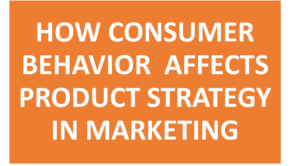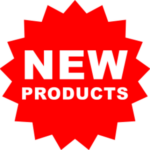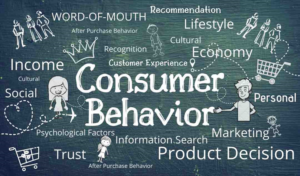HOW CONSUMER BEHAVIOR AFFECTS PRODUCT STRATEGY IN MARKETING

When the company get an understanding of consumer behavior- specifically the behavior of your potential consumers — it can accurately determine:
• What products your customers are looking for.
• What benefits and features will move them to purchase your product?
• What will keep your customer away from your competitors.
You can then use that knowledge to create a product strategy that will enhance the chances of your products being successful in the marketplace. Companies that have a grasp on consumer behavior more often develop products that contain the features and benefits that the market demands and they almost always come out ahead of their competition.

CONSUMER BEHAVIOR AND YOUR PRODUCT IDENTIFICATION
Consumer purchases are base on the wants and desire which determine why they want to buy it. It will determine you to analyse and define objectively what you’re selling. When you can take a step into their shoes and view your product in the same way they will, you can better entice them to make a purchase. Consumers go through a series of steps before making a purchase; you can guide them through each one of those steps by not only objectively looking at your product and pointing out features and benefits.
Your product definition will be:

- Specific: It must be easy to understand and clearly identifiable by the consumer. Marketable: It must carry marketing value. In other words, you need to determine why consumers should pay attention to your product.
- Profitable: Obviously the goal of the product definition is to make a consumer want to purchase that product and provide you with a profit.
- Achievable: Your definition must bе true and the consumer who purchases your product must be able to sec the truth. For example, you don’t want to say that your dish soap softens hands when it doesn’t actually do so.
- Vision matching: Your product must meet the vision you’ve created in your product definition.
- Easily understood: Flashy or wordy definitions often only confuse consumers, so make sure yours is easily understood. Would a fifth-grade student understand your product definition? If not, it may be time to reconsider a rewrite.
- Easily communicated: Can your definition be easily communicated or are consumers stumbling over your message and having to review it several times to get your point? The goal is to be able to use your product definition in a way that consumers have an understanding of that product within 30 seconds.
An example of a product definition might be “one-of-a-kind, hand-crafted engagement rings for women.” You can see how this example fits each of the previous requirements:
- Specific: It tells the consumer exactly what the product is.
- Marketable: The rings are one-of-a-kind and hand-crafted.
- Profitable: A consumer would want to make a purchase based on this definition if she were looking for a one-of-a-kind ring.
- Achievable: If the consumer purchases the ring, it will be one-of-a-kind and no one else will have one like it.
- Vision matching: If the consumer is looking for a one-of-a-kind, hand-crafted ring (and that’s what she visualizes when reading your product description), she can in fact purchase a ring that meets that visualization.
- Easy to understand: When a consumer reads this description, she will know exactly what she is getting.
- Easily communicated: You can explain what the product is in 30 seconds or less and the consumer walks away with a clear understanding. Consumer behavior and your product name creating a product name is the fun phase of product strategy. However, keep in mind that when crafting your product name, it’s more important to be descriptive than creative, Often people try to be so creative that their product names hide the messages of what their products do, And make sure that your name is memorable, relevant, and of course, easy to pronounce. It’s important to understand that if your product name is difficult to pronounce or spell, consumers will have trouble finding your product or asking for it by name.
CONSUMER BEHAVIOUR AND PRODUCT NAME

Consumers often purchase based on emotion, and studies have shown that product names that focus on emotions tend to sell better than those that simply focus on function. So, if you really want to be creative when developing your product name, concentrate more on creating a descriptive product name that focuses on emotion rather than a function. An example of this is the fragrance put out by Clinique called Happy. Consumers have the perception that if they wear this fragrance, they will be happy. So clearly this influences their decision to purchase the fragrance.
Your product name is dependent on which your target market is as well. If your target is edgy and more alternative, you need to crеatе a name that attracts them. If you’re dealing more with seniors, however, your name will be very different. You know your target market more than anyone else (or at least you should!), so choose a name that appeals to that market. One of the best ways to determine a name for a product is to spend a few moments brainstorming.

However, you need to follow these rules:
• You cannot reject or criticize any idea.
• Consider this free-form brain dump. In other words, write down anything that comes to mind. Write down a few adjectives, and then grab a thesaurus and let your mind wander.
• Keep a written record of everything. Keeping your thoughts locked up in your brain isn’t enough — you’re human, so you’ll forget things.
• When you have a list of ideas, rank them one by one.
• Evaluate pros and cons for each idea.
• Get the opinion of trusted external sources.
If your product is an extension of a product line, be sure the name fits in with brand structure of that product line and offers you the possibility for product add-ons.
CONSUMER BEHAVIOR AND PRODUCT DESCRIPTION
When crafting a product or service description, your goal is to address your chosen consumers specifically and tell them in one sentence what the product or service can do for them. To do so, you need to determine whether your offering is a product, a service, a solution, a feature, an accessory, a tool, or some other thing. Come up with a noun that describes your item.
It’s critical that you explain in only one clear sentence why your product is perfect for a specific buyer and what it does best. The reason this is so important is because clarity and the ability to communicate the purpose of the product is crucial. If you’re using more than one sentence, the description can become difficult to understand, and worse yet difficult to remember. The more sentences and words used the less clarity in the description.

Consumer behaviour and your description of functionality, features, and benefits
The idea of consumer behaviour is that you can take the knowledge of why your consumers behave the way they do and use that information to increase the chances of them purchasing from you. In order to do this, you must define the target market that you’re aiming toward and single out the benefits and features that matter to that specific target market. The following steps help you identify functionality, features, and benefits of your product:
- Evaluate each feature, benefit, and function to determine how your consumer will see that the product has value. List each one by one and recognize the consumer’s need or want that you are satisfying. And remember that purchases are made based on a need or want that a consumer feels.
- Investigate the product by asking current customers how they use it and what they like about it. This investigation can help you identify whether there is need to make any product changes to enhance the experience your consumer is having with your product. Seeing how consumers are using your product can make you aware of any unusual usages, thereby inspiring you with new product ideas.
- Evaluate whether your product delivers true benefits, features, and functionality. The more a product brings to the table, the more the importance of price diminishes. Consumers don’t purchase based on price; they purchase based on benefits. So, by evaluating the benefits, you can analyze whether your product is delivering in the way that you intended it to. It also allows you to see changes or enhancements that you need to make in order to create customer loyalty.
Keep in mind that all products and services have obvious benefits to your consumers, such as price and convenience of distribution, but there are also hidden benefits like customer service and guarantees. Don’t forget these. By finding these hidden benefits and bringing them to the forefront, you have the ability to make your product more valuable in the mind of your consumers.
For example, a consumer may walk into your place of business to purchase your product because of the convenience and price that you offer, but when you share with him the exceptional customer service that he will receive or the guarantee surrounding your product, he will have a higher perceived value of purchasing from you. After you’ve identified each feature, function, or benefit, prioritize them according to your market segments and the target markets within that segment that you want to reach. This prioritization can help you determine development of the product going forward.
CONSUMER BEHAVIOR AND PRODUCT’S ADAPTABILITY
When evaluating product adaptability, you’re assessing the flexibility that your product has to adjust to market demands and changes. When consumers purchase a product, they often evaluate the value of that product and whether it’s adaptable to their lifestyle. Lack of adaptability can detour a consumer from the purchase.
The following five factors help you measure the adaptability of your product:

Attractiveness: It’s important that you can entice consumers to try your product and allow them to experience it before purchasing. Samples and trials are great for this, because they allow consumers to begin the adaptation process of changing products without financial risk. It also shows that you believe so much in your product that you’re willing to let consumers “try before they buy.”
Compatibility: You want your product to fit the usage of consumers today. If it doesn’t, consumers simply won’t purchase from you.
Complexity: You must offer a product that consumers understand. Even though you may feel that your product is innovative and presents a new way of doing things,
your consumers may not necessarily see it the same way. And then they won’t make the purchase. It’s vital that consumers understand not only the benefits, but the purpose behind your product.
Product advantage: You want to be able to stand against your competitors and be the product that consumers choose. If you can’t identify an advantage, consumers won’t be able to either.
Visibility: It’s easier for consumers to adapt to a new product when they see others using the product successfully. You want your product to be visible to consumers, because the visibility diminishes the fear of the unknown. By evaluating the adaptability of your product, you can see how flexible your product is and how flexible your consumers believe it to be. Consumers don’t particularly embrace change, so if they can view a product as easy to use, you will decrease their anxiety about making the purchase.
Evaluating adaptability helps when creating your marketing plan, because if your product proves to be adaptable in the marketplace, you can use that as a benefit to your product. If you find that your product isn’t as adaptable as it needs to be, you can begin to make the necessary changes to appeal to consumers. When you attain an appropriate level of adaptability, you create a stability that allows you to adapt without shaking the core of what your product represents.
HOW CONSUMER BEHAVIOR AFFECTS PRODUCT STRATEGY IN MARKETING
HOW CONSUMER BEHAVIOR AFFECTS PRODUCT STRATEGY IN MARKETING
HOW CONSUMER BEHAVIOR AFFECTS PRODUCT STRATEGY IN MARKETING